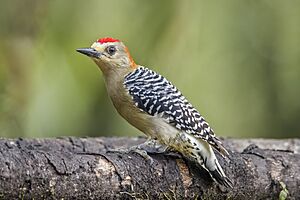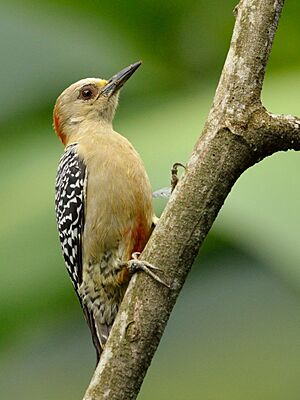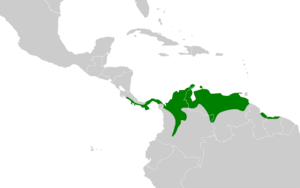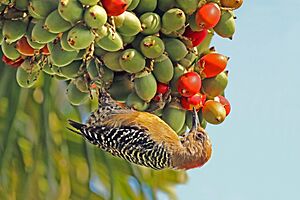Red-crowned woodpecker facts for kids
Quick facts for kids Red-crowned woodpecker |
|
|---|---|
 |
|
| Male | |
 |
|
| Female both M. r. rubricapillus, Columbia |
|
| Conservation status | |
| Scientific classification | |
| Genus: |
Melanerpes
|
| Species: |
rubricapillus
|
 |
|
| Synonyms | |
|
Melanerpes subelegans |
|
The red-crowned woodpecker (Melanerpes rubricapillus) is a colorful bird. It belongs to the woodpecker family. You can find this bird in several countries. These include Costa Rica, Panama, Colombia, Venezuela, Guyana, Suriname, and Tobago.
Contents
About the Red-Crowned Woodpecker
This woodpecker is a medium-sized bird. It measures about 16 to 18.5 centimeters (6 to 7 inches) long. It weighs between 40 and 65 grams (1.4 to 2.3 ounces).
How to Identify a Red-Crowned Woodpecker
Male and female red-crowned woodpeckers look similar. Their main difference is on their heads.
- Males: They have a pale yellow or whitish forehead. Their crown (top of the head) is bright red. The back of their neck is orange-red.
- Females: They also have a pale yellow or whitish forehead. But their crown is a pale gray-buff or whitish. Their nape (back of the neck) is reddish or orange-red.
Both sexes have grayish-buff cheeks, chin, and throat. Their back is striped black and white. Their rump is white. Their wings are black with white stripes. The tail is black with white stripes on some feathers.
The belly area is usually grayish-buff. It often has a yellowish tint. There is a reddish or orange-red patch in the middle of their belly. The lower sides and under their tail have black stripes. They have a long, dark bill. Their eyes are red or brown.
Young Woodpeckers
Young red-crowned woodpeckers look a bit duller than adults. Their colors are not as bright. The stripes on their upper body are less clear. Their belly patch is paler.
Where Red-Crowned Woodpeckers Live
The red-crowned woodpecker lives in many different places. It can be found in both wet and dry areas.
Habitats They Love
They live in forests, especially where trees lose their leaves. They also like forest edges and clearings. You can find them in coastal areas with shrubs. They also live in mangrove swamps, farms, and gardens.
These birds usually live from sea level up to about 1,700 meters (5,600 feet) high. In Venezuela, they can be found even higher, up to 1,900 meters (6,200 feet).
Red-Crowned Woodpecker Behavior
Red-crowned woodpeckers stay in the same area all year. They do not migrate.
What Do They Eat?
These woodpeckers eat a lot of different foods. A big part of their diet is fruits and berries. This includes fruits grown by people, like papayas and bananas. They also eat many kinds of insects and spiders. Unlike some other woodpeckers, they eat fewer wood-boring beetle larvae. They also drink nectar from flowers.
They look for food at all levels of their habitat. However, they prefer the middle and lower parts of trees. You usually see them alone or in pairs. They find insects by poking, picking, or hammering on wood. They reach for fruit. If a fruit is too big, they will peck it open. They sometimes visit bird feeders. They can be a bit of a problem in fruit farms because they eat the crops.
Reproduction and Life Cycle
The breeding season for red-crowned woodpeckers changes depending on the location.
- In Costa Rica and Panama, it's from February to July.
- In Colombia, it's from May to June.
- In Venezuela, it's from May to November.
- In Tobago, it's from March to July.
Sometimes, a pair will raise two groups of young in one year. The male and female stay together all year.
Nesting Habits
Both parents help dig the nest hole. They usually make it in a large tree trunk or branch. Sometimes, they use a big cactus or even a fence post. Nests are typically 3 to 23 meters (10 to 75 feet) above the ground.
A female usually lays three or four eggs. But often, only two young birds grow big enough to leave the nest. Both parents sit on the eggs. The eggs hatch after about 10 days. The young birds leave the nest 31 to 33 days after hatching. Both parents take care of the young birds. They continue to care for them for at least a month after they leave the nest.
Sounds They Make
The red-crowned woodpecker has a special call. It often sounds long and wavy. It ends with a sudden note, like "churr, churr, krr-r-r-r." They also make a "wícka, wícka" sound when showing off. They have chattering calls too.
Both male and female woodpeckers drum on trees during breeding season. They also tap softly near their nest hole.
Conservation Status
The IUCN (International Union for Conservation of Nature) has checked on the red-crowned woodpecker. They have listed it as a species of "Least Concern." This means it is not currently in danger of disappearing.
The bird has a large area where it lives. There are at least half a million adult birds. Their population seems to be stable. No big threats have been found right now. This woodpecker is common in most places it lives. It is very common in Costa Rica and Panama. It also lives in several protected natural areas. Sometimes, cutting down some trees can even help them. This creates more open woodlands, which they like.



